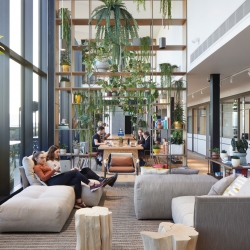November 11, 2021
Majority of employees lack confidence in their company’s return-to-work strategy
 Humanyze has released the second installment of the 2021 Future of Work Report, a holistic analysis of the evolution of work throughout the pandemic and employee sentiments about the post-pandemic future of the workplace. Nearly 2,300 survey responses were collected from individual employees and people managers, and compared to responses from the spring 2021 report, to identify key changes over the last 6 months.
Humanyze has released the second installment of the 2021 Future of Work Report, a holistic analysis of the evolution of work throughout the pandemic and employee sentiments about the post-pandemic future of the workplace. Nearly 2,300 survey responses were collected from individual employees and people managers, and compared to responses from the spring 2021 report, to identify key changes over the last 6 months.
The findings from both surveys were then measured against data from the Humanyze Platform to compare how employees and managers feel, with how they actually work.
“Looking at subjective workforce sentiments and how work objectively gets done within organisations gives us a holistic view of the pandemic’s impacts and what this could mean for the future of work post-COVID,” said Taemie Kim, Co-founder and Chief Scientist, Humanyze.
“Measuring our own analytics against these survey responses revealed that, although employees seem to be effectively adapting to remote work as the pandemic continues, many challenges and concerns remain.”
At a time when employee attrition and operational resilience are top concerns for employers, the report’s latest findings further emphasize the importance of a data-driven, people-centric approach to workplace decision-making.
Biggest challenges and what’s at risk
When asked about their greatest work challenge during the pandemic, the top response for employees was work-life balance, followed by the lack of informal social interactions with colleagues, managers, and leadership. Managers, on the other hand, listed employee attrition and disengagement as their main hurdle, followed by decreased productivity.
“A big driver of employee engagement and productivity is the ability to seamlessly interact with coworkers, which was obviously hindered after the abrupt shift to remote work in 2020,” said Ben Waber, Co-founder and President of Humanyze. “If employees feel disconnected from the organisation, it ultimately seeps into disengagement with the work itself.”
After the start of the pandemic, Humanyze observed a 21 percent decrease in collaboration with “weak ties”, peripheral colleagues that you interact with less frequently but are essential for engagement, knowledge-sharing, and innovation. While this remains the case today, not all employee collaboration has suffered. Compared to pre-pandemic, Humanyze data suggests meaningful increases in cross-level, cross-team collaboration, and communication between employees and their immediate colleagues and managers.
“Interestingly, our data shows employees are changing how they work, and doing so in ways that can actually help address many of the challenges mentioned in the surveys”, said Waber. “Remote work undeniably comes with its challenges, but it’s also showing us that employees can adapt over time.”
Shaping the post-pandemic future of work
Although employees and managers seem to be adapting to remote work and collaborating more effectively since the start of the pandemic, one of the more concerning recent takeaways is an increased lack of employee confidence in their company’s future of work. Of those surveyed, 63 percent lack full confidence in their company’s post-pandemic workplace strategy being the right decision for employees, compared to 46 percent in April 2021.
[perfectpullquote align=”right” bordertop=”false” cite=”” link=”” color=”” class=”” size=””]“If employees feel disconnected from the organisation, it ultimately seeps into disengagement with the work itself.”[/perfectpullquote]
Survey findings demonstrate a need for better communication and transparency from executive leadership, with over 50 percent of employees reporting they do not feel fully informed about their company’s post-COVID plans or how decisions get made. Around 20 percent of managers cited having absolutely no involvement or say, showing leaders have significant work ahead of them to achieve a more inclusive, transparent culture.
Although more than half of managers cited the use of employee surveys to understand employee preferences, 70 percent reported their company is not leveraging any other data or workplace technologies to inform strategies. This suggests that, even in the digital age, objective data is still not a driving force for informing critical business and people decisions.
“Without effective communication or the necessary supporting data to inspire confidence in the company’s strategy, it makes perfect sense employees have these concerns and doubts,” added Waber. “As we see from our own data, employees have proven their resiliency in times of change, but leadership must establish trust in order to retain and support their people.”
What managers and employees want
One key takeaway from the fall survey is that employees want continued flexibility, but still value the benefits of working with colleagues in-person. Although the majority of employees remain open to going back to the office in some capacity and listed in-person collaboration with colleagues and leaders as their top reason for doing so, 37 percent continue to agree they’d prefer to not go in at all.
When asked about their preferences in a hybrid work scenario, employees and managers both expressed a desire for thoughtfully-planned coordination. Forty percent of employees would want a fixed return-to-office schedule where they see the same people each time, while 45 percent of managers also ranked a fixed schedule as their top preference.
“Companies must realise, every team is different,” said Kim. “While a universally equal policy from the top down might sound best, and may be easiest, it impacts groups differently. Where it works for some, it fails for others. Therefore, manager input and employee surveys combined with leveraging available data and tools are critical to correctly identifying individual teams’ best working styles for post-pandemic planning.”
Image:Fora













